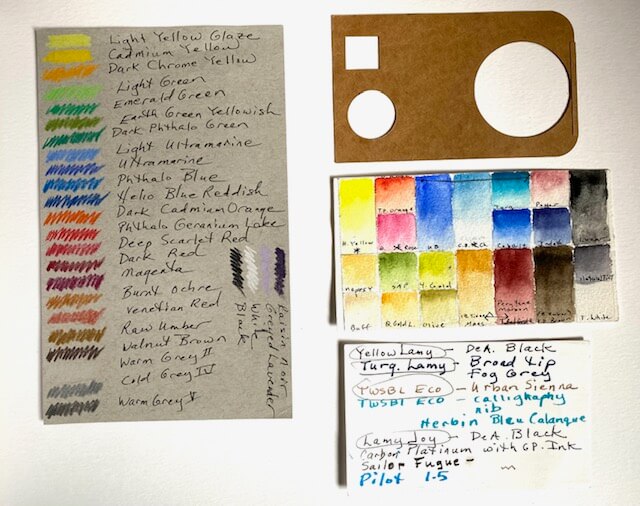Followup: Field Journal DIY class
You did it! Made a nature journal in less than two hours with all that cutting, hole punching, and sewing. It was just a pleasure to work with you and thanks for helping and supporting each other. Since we had little time to write in the journal I wanted to follow up with some comments that I hope you find useful.
- Live links from handout:
- Roseanne Hanson’s video on the journal sewing.
- Types of Strathmore Papers. Feel free to use whatever brand of paper you want.
- Sewing elastic can be replaced with leather shoestrings or ribbons on the bias – whatever you use should have some stretch to it.
- Watercolor Paper: Most watercolor paper is heavy (90lb., 140lb., and 300lb). The 90 lb. is just fine for journals and thick enough to prevent bleed through of watercolor, fountain pens, or markers. Watercolor paper comes in grades – the one you have isn’t 100% cotton but is more accepting of pen and ink.
- Papers from class: Experiment with each type of paper. If the paper is for “Dry Media” try watercolor anyway. It’s important to see what works and what doesn’t and why. Sometimes you are surprised.
- Mixed Media Paper: This just might be the best type of you use lots of inks, pencils, watercolor, etc.
- Size of journal: I used to use really small journals but they are limiting, especially when you have a lot of data, observations, and questions. In a 6″ x 9″ journal I can still draw small landscapes (these take a lot less time) – just as I did in my smaller journals. A 12″ x 9″ spread can hold an entire story about “place”.
- What can you carry in the plastic sleeve?: I always carry samples of my current watercolor palette and colored pencils I use. I also love fountain pens and carry samples of their inks and writing style. The square/circle template is made from a file folder using a punch and I use it for making circles on my pages. What sorts of things might you carry to help with your journaling??
- Working in the Field vs. Studio: In the studio you have control over time, materials, and environment. I like creating pages in the studio but it is vastly different than working in the field. In the field you have little control over time and environment (the bird keeps moving, it is getting chilly, etc.) and your materials have to be more limited. However, it is more exciting and immediate.It also encourages more acceptance of your drawings because they are done quickly.
- If your end boards look boring – add stickers or glue things on to them! My granddaughter sent me a bunch of STEM (Science, Technology, Engineering, Mathematics) stickers and I have used those along with stickers from state and national parks or monuments.
- Remember! You can journal with just a piece of paper and a pencil!




Michele… what kind of pen or ink ️ do you use with watercolors? I’ll ask you this tomorrow during class.
Oh my. What a good question. Sounds like a topic for another class. I am about to send out a link to the followup for yesterday’s class. There is a photo where you can see what I am currently using. I like permanent and water soluble inks depending on what I want to do – mostly fountain pens. Micron or thin Sharpies are good too but they don’t make as interesting a line that flexible fountain pen nibs provide.
How wonderful having so much information available in one place. I love the clickable links.
Great. Glad it works.
How wonderful having so much information available in one place. I love the clickable links.